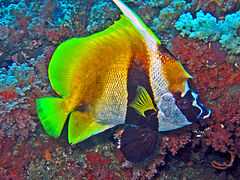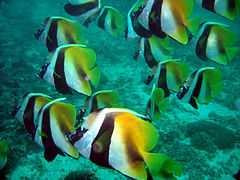Heniochus monoceros
| Heniochus monoceros | |
|---|---|
 | |
| Heniochus monoceros from Maldives | |
| Conservation status | |
| Scientific classification | |
| Kingdom: | Animalia |
| Phylum: | Chordata |
| Class: | Actinopterygii |
| Order: | Perciformes |
| Family: | Chaetodontidae |
| Genus: | Heniochus |
| Species: | H. monoceros |
| Binomial name | |
| Heniochus monoceros G. Cuvier, 1831 | |
| Synonyms | |
| |
Heniochus monoceros, the Masked Bannerfish, is a tropical fish of the family Chaetodontidae.
Description
Heniochus monoceros can attain a maximum length of 24 centimetres (9.4 in) in males. The body is laterally flattened, with a basic white or yellowish color and a broad middle black band running vertically from the dorsal fin to the pelvic fins. On the head it shows a black mask with white lines and a couple of bony knobs. The nape is brown. The fish's caudal, dorsal fin and the rear part of anal are most commonly bright yellow, while the pelvic fins are black. Adults have a quite short banner. Juvenile fishes are solitary. This species is oviparous. It feeds on coral polyps, small invertebrates and other bottom-dwelling animals.

Distribution
This species has an Indo-Pacific distribution, from east African coast to the Tuamotu Islands, Japan, Papua New Guinea, the Great Barrier Reef, New South Wales and Tonga.
Habitat
Masked Bannerfish typically lives in coastal waters and in lagoon among the coral reefs, at a depth of 2–25 metres (6 ft 7 in–82 ft 0 in).[1]
References
- ↑ Dianne J. Bray, 2011, Masked Bannerfish, Heniochus monoceros, in Fishes of Australia, accessed 26 Sep 2014, http://www.fishesofaustralia.net.au/home/species/2413
